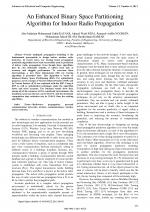| 4/2013 - 18 |
An Enhanced Binary Space Partitioning Algorithm for Indoor Radio PropagationKAUSAR, A. S. M. Z. |
| View the paper record and citations in |
| Click to see author's profile in |
| Download PDF |
Author keywords
radiowave propagation, personal communication networks, wireless communications, wireless sensor networks
References keywords
tracing(12), propagation(10), research(9), progress(9), electromagnetics(9), space(8), pier(8), prediction(6), optimization(6), indoor(6)
Blue keywords are present in both the references section and the paper title.
About this article
Date of Publication: 2013-11-30
Volume 13, Issue 4, Year 2013, On page(s): 103 - 110
ISSN: 1582-7445, e-ISSN: 1844-7600
Digital Object Identifier: 10.4316/AECE.2013.04018
Web of Science Accession Number: 000331461300018
SCOPUS ID: 84890200621
Abstract
Precise multipath propagation modeling is the fundamental prerequisite to design indoor wireless radio networks. In recent years, ray tracing based propagation prediction algorithms have been successfully used in prediction of indoor radio propagation. Even though these algorithms have its own noticeable benefits, it suffers from lack of accuracy and sluggish performance. To overcome these shortcomings, a new three dimensional (3D) ray tracing algorithm is presented here. This algorithm is based on balanced Binary Space Partitioning (BSP). For optimization purposes, novel concepts of Nearest Object Priority (NOP) and In Contact Surface (ICS) are combined with this BSP. Using of BSP as well as optimization techniques make the algorithm faster and more accurate. The obtained results show that, among all of the scenarios of five considered environments, the maximum accuracy increase can be 87.27% and the maximum computation time reduction can be 33.60% than the existing algorithms. |
| References | | | Cited By |
Web of Science® Times Cited: 0
View record in Web of Science® [View]
View Related Records® [View]
Updated 2 days, 23 hours ago
SCOPUS® Times Cited: 2
View record in SCOPUS® [Free preview]
View citations in SCOPUS® [Free preview]
[1] An efficient indoor ray-tracing propagation model with a quasi-3D approach, Grubisic, Stevan, Carpes Jr, Walter Pereira, Journal of Microwaves, Optoelectronics and Electromagnetic Applications, ISSN 2179-1074, Issue 2, Volume 13, 2014.
Digital Object Identifier: 10.1590/S2179-10742014000200005 [CrossRef]
Disclaimer: All information displayed above was retrieved by using remote connections to respective databases. For the best user experience, we update all data by using background processes, and use caches in order to reduce the load on the servers we retrieve the information from. As we have no control on the availability of the database servers and sometimes the Internet connectivity may be affected, we do not guarantee the information is correct or complete. For the most accurate data, please always consult the database sites directly. Some external links require authentication or an institutional subscription.
Web of Science® is a registered trademark of Clarivate Analytics, Scopus® is a registered trademark of Elsevier B.V., other product names, company names, brand names, trademarks and logos are the property of their respective owners.
Faculty of Electrical Engineering and Computer Science
Stefan cel Mare University of Suceava, Romania
All rights reserved: Advances in Electrical and Computer Engineering is a registered trademark of the Stefan cel Mare University of Suceava. No part of this publication may be reproduced, stored in a retrieval system, photocopied, recorded or archived, without the written permission from the Editor. When authors submit their papers for publication, they agree that the copyright for their article be transferred to the Faculty of Electrical Engineering and Computer Science, Stefan cel Mare University of Suceava, Romania, if and only if the articles are accepted for publication. The copyright covers the exclusive rights to reproduce and distribute the article, including reprints and translations.
Permission for other use: The copyright owner's consent does not extend to copying for general distribution, for promotion, for creating new works, or for resale. Specific written permission must be obtained from the Editor for such copying. Direct linking to files hosted on this website is strictly prohibited.
Disclaimer: Whilst every effort is made by the publishers and editorial board to see that no inaccurate or misleading data, opinions or statements appear in this journal, they wish to make it clear that all information and opinions formulated in the articles, as well as linguistic accuracy, are the sole responsibility of the author.





